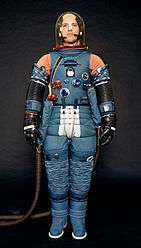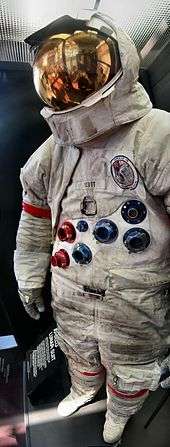Apollo/Skylab A7L

The A7L Apollo & Skylab spacesuit is the primary pressure suit worn by NASA astronauts for Project Apollo, the three manned Skylab flights, and the Apollo-Soyuz Test Project between 1968 and the termination of the Apollo program in 1975. The "A7L" designation is used by NASA as the seventh Apollo spacesuit designed and built by ILC Dover (a Playtex division when the suit was designed). The A7L is a design evolution of ILC's initial design A5L and the A6L, which introduced the integrated thermal and micrometeroid cover layer. After the deadly Apollo 1 fire, the suit was upgraded to be fire-resistant and given the designation A7L.[2][3]
Basic design


The basic design of the A7L suit was a one piece, five-layer "torso-limb" suit with convoluted joints made of synthetic and natural rubber at the shoulders, elbows, wrist, hips, ankle, and knee joints, "link-net" meshing to prevent the suit from ballooning at the joints, and a shoulder "cable block" assembly to allow the shoulder to be extended and retracted by its wearer. Metal rings at the neck and forearms allowed for the connection of the pressure gloves and the famous Apollo "fishbowl helmet" (adopted by NASA as it allowed an unrestricted view, as well as eliminating the need for a visor seal required in the Mercury and Gemini and Apollo Block I spacesuit helmets). A cover layer, which was designed to be fireproof after the deadly Apollo 1 fire, was attached to the pressure garment assembly and was removable for repairs and inspection. All A7L suits featured a vertical zipper that went from the shoulder assembly of the suit down to the crotch for donning and doffing the suit.
Specifications
- Name: Apollo A7L Spacesuit
- Manufacturer: ILC Dover and Hamilton Standard (primary life support systems)[4]
- Missions: Apollo 7-14[4]
- Function: Intra-vehicular activity (IVA), orbital Extra-vehicular activity and terrestrial Extra-vehicular activity (EVA)[4]
- Operating Pressure: 3.7 psi (25.5 kPa)[4]
- IVA Suit Weight: 62 lb (28.1 kg)[4]
- EVA Suit Weight: 76 lb (34.5 kg)[4]
- Total EVA Suit Weight 200 lb (91 kg)[4]
- Primary Life Support: 6 hours[4]
- Backup Life Support: 30 minutes[4]
Extravehicular Pressure Garment Assembly


Torso Limb Suit Assembly
Between Apollos 7 and 14, the two lunar module astronauts, the Commander (CDR) and Lunar Module pilot (LMP), had Torso Limb Suit Assemblies (TSLA) with six life support connections placed in two parallel columns on the chest. The 4 lower connectors passed oxygen, an electrical headset/biomed connector was on the upper right, and a bidirectional cooling water connector was on the upper left.
Integrated Thermal Micrometeoroid Garment
Covering the Torso Limb Suit Assembly was an Integrated Thermal Micrometeoroid Garment (ITMG). This garment protected the suit from abrasion and protected the astronaut from thermal solar radiation and micrometeoroids which could puncture the suit. The garment was made from thirteen layers of material which were (from inside to outside):rubber coated nylon, 5 layers of aluminized Mylar, 4 layers of nonwoven Dacron, 2 layers of aluminized Kapton film/Beta marquisette laminate, and Teflon coated Beta filament cloth.
Additionally, the ITMG also used a patch of 'Chromel-R' woven steel (the familiar silver-colored patch seen especially on the suits worn by the Apollo 11 crew) for abrasion protection from the Portable Life Support System (PLSS) backpack. Chromel-R was also used on the uppers of the lunar boots and on the EVA gloves. Finally, patches of Teflon were used for additional abrasion protection on the knees waist and shoulders of the ITMG.
Starting with Apollo 13, a red band of Beta cloth was added to the commander's ITMG on each arm and leg, as well as a red stripe on the newly added EVA central visor assembly. The stripes, initially known as "Public Affairs stripes" but quickly renamed "commander's stripes", made it easy to distinguish the two astronauts on the lunar surface and were added by Brian Duff, head of Public Affairs at the Manned Spacecraft Center, to resolve the problem for the media as well as NASA of identifying astronauts in photographs.[5]
Liquid Cooling Garment
Lunar crews also wore a three-layer Liquid Cooling and Ventilation Garment (LCG) or "union suit" with plastic tubing which circulated water to cool the astronaut down, minimizing sweating and fogging of the suit helmet. Water was supplied to the LCG from the PLSS backpack, where the circulating water was chilled by an ice sublimator.
Intravehicular (CMP) Pressure Garment Assembly

Torso Limb Suit Assembly
The Command Module pilot (CMP) had a TSLA similar to the commander and lunar module pilot, but with unnecessary hardware deleted since the CMP would not be performing any extravehicular activities. For example, the CMP's TSLA had only one set of gas connectors instead of two, and had no water cooling connector. Also deleted was the pressure relief valve in the sleeve of the suit and the tether mounting attachments which were used in the lunar module. The TSLA for the CMP also deleted an arm bearing that allowed the arm to rotate above the elbow.
Intravehicular Cover Layer
Command module pilots only wore a three-layer Intravehicular Cover Layer (IVCL) of nomex and beta cloth for fire and abrasion protection.
Constant Wear Garment
The CMP wore a simpler cotton fabric union suit called the Constant Wear Garment (CWG) underneath the TSLA instead of the water cooled Liquid Cooling Garment. His cooling came directly from the flow of oxygen into his suit via an umbilical from the spacecraft environmental control system. When not performing lunar EVA's, the LMP and CDR also wore a CWG instead of the LCG.
A7LB Spacesuit (Apollo, Skylab and ASTP)
Apollo 15-17



For the last three Apollo lunar flights Apollos 15, 16, and 17, the CDR and LMP started wearing a new moonwalking suit designed for longer duration J-series missions, in which three EVAs would be conducted and the lunar rover (LRV) would be used for the first time. Originally developed by ILC-Dover as the "A9L," but given the designation "A7LB" by NASA,[6] the new suit incorporated two new joints at the neck and waist. The waist joint was added to allow the astronaut to sit on the LRV and the neck joint was to provide additional visibility while driving the LRV. Because of the waist joint, the six life-support connectors were rearranged from the parallel pattern to a set of two "triangles," and the up-and-down zipper was relocated to the left front side of the suit, going around the back, and terminating on the right shoulder.[3]
In addition, the EVA backpacks were modified to carry more oxygen, lithium hydroxide (LiOH), more power, and cooling water for the longer EVAs.[3] To facilitate these longer EVAs, small energy bars were carried in special pouches beneath the interior of the suit helmet ring, and the astronauts wore collar-like drinking water bags beneath the outer suit.
Because the J-series CSMs incorporated the Scientific Instrument Module (SIM) Bay, which used special film cameras similar to those used on Air Force spy satellites, and required a "deep space" EVA for retrieval, the CMP for each of the three J-series missions wore a five-connector A7LB-based H-series A7L suits, with the liquid cooling connections eliminated as the CMP would be attached to a life-support umbilical (like that used on Gemini EVAs) and only an "oxygen purge system" (OPS) would be used, along with a "red apple" lanyard, for emergency backup in the case of the failure of the umbilical. The CMP wore the commander's red-striped EVA visor assembly, while the LMP, who performed a "stand-up EVA" (to prevent the umbilical from getting "fouled up" and to store the film into the CSM) in the spacecraft hatch and connected to his normal life-support connections, wore the plain white EVA visor assembly.
Specifications
- Name: Apollo A7LB Spacesuit
- Manufacturer: ILC Dover and Hamilton Standard (primary life support systems)[4]
- Missions: Apollo 15-17[4]
- Function: Intra-vehicular activity (IVA), orbital Extra-vehicular activity and terrestrial Extra-vehicular activity (EVA)
- Operating Pressure: 3.7 psi (25.5 kPa)[4]
- IVA Suit Weight: 64.6 lb (29.3 kg)[4]
- EVA Suit Weight: 78 lb (35.4 kg)[4]
- Total EVA Suit Weight 212 lb (96.2 kg)[4]
- Primary Life Support: 7 hours (420 minutes)[4]
- Backup Life Support: 30 minutes[4]
Skylab
For the three manned Skylab missions, all three astronauts wore a slightly modified A7LB suit for launch, docking, undocking, and EVA. The suit had a simplified and less expensive Integrated Thermal and Micrometeroid Garment (ITMG), and a simpler and less expensive extravehicular visor assembly.[7]
With the exception of the Orbital Workshop (OWS) repairs carried out by Skylab 2 and Skylab 3, all of the Skylab EVAs were conducted in connection to the routine maintenance carried out on the Apollo Telescope Mount, which housed the station's solar telescopes. Because of the short duration of those EVAs, and as a need to protect the delicate instruments, the Apollo lunar EVA backpack was replaced with a Gemini-style umbilical assembly, except that it was modified to incorporate both breathing air (Skylab's atmosphere was 80% oxygen and 20% nitrogen at 5 psi) and liquid water for cooling. The assembly was worn on the astronaut's waist and served as the interface between the umbilical and the suit. An emergency oxygen pack was strapped to the wearer's right thigh and was able to supply a 30-minute emergency supply of pure oxygen in the case of umbilical failure. An EVA visor assembly similar to that used today on the Shuttle/ISS Extravehicular Mobility Unit was worn over the pressure helmet, but Apollo EVA gloves were used.
Specifications
- Name: Skylab A7LB Spacesuit
- Manufacturer: ILC Dover and AiResearch (bought by AlliedSignal Corporation)[4]
- Missions: Skylab 2-4[4]
- Function: Intra-vehicular activity (IVA) and orbital Extra-vehicular activity (EVA)[4]
- Operating Pressure: 3.7 psi (25.5 kPa)[4]
- IVA Suit Weight: 64.6 lb (29.3 kg)[4]
- EVA Suit Weight: 72 lb (32.7 kg)[4]
- Total EVA Suit Weight 143 lb (64.9 kg)[4]
- Primary Life Support: Vehicle Provided[4]
- Backup Life Support: 30 minutes[4]
ASTP

For the Apollo-Soyuz Test Project, NASA decided to use the A7LB CMP pressure suit assembly worn on the J-missions with a few changes to save cost and weight since an EVA was not planned during the mission. The changes included a simplified cover layer which was cheaper, lighter and more durable as well as the removal of the pressure relief valve and unused gas connectors. No EVA visor assemblies or EVA gloves were carried on the mission.[8]
The ASTP A7LB suit was the only Apollo suit to use the NASA "worm" logo, a logo that was used between 1981 and 1992 on all of NASA's pressure, space, and flight suits, and all Space Shuttle orbiters.
Specifications
- Name: Apollo A7LB Spacesuit
- Manufacturer: ILC Dover[4]
- Missions: ASTP[4]
- Function: Intra-vehicular activity (IVA)[4]
- Operating Pressure: 3.7 psi (25.5 kPa)[4]
- IVA Suit Weight: 64.6 lb (29.3 kg)[4]
- Primary Life Support: Vehicle Provided
References
- ↑ "Science Friday Archives: How to Dress for Space Travel". NPR. March 25, 2011.
- ↑ "SP-4011:Skylab A Chronology". NASA. 1977. Archived from the original on 17 July 2007. Retrieved 2007-07-07.
- 1 2 3 Charles C. Lutz; Harley L. Stutesman; Maurice A. Carson; James W. McBarron II (1975). "Development of the Extravehicular Mobility Unit". NASA. Archived from the original on 1 August 2007. Retrieved 10 January 2016.
- 1 2 3 4 5 6 7 8 9 10 11 12 13 14 15 16 17 18 19 20 21 22 23 24 25 26 27 28 29 30 31 Kenneth S. Thomas; Harold J. McMann (2006). US Spacesuits. Chichester, UK: Praxis Publishing Ltd. p. 32. ISBN 0-387-27919-9.
- ↑ "Commander's Stripes". Apollo Lunar Surface Journal. NASA.
- ↑ Harold J. McMann; Thomas, Kenneth P. US Spacesuits (Springer Praxis Books / Space Exploration). Praxis. p. 140. ISBN 0-387-27919-9.
- ↑ "Space Suit Evolution" (PDF). Space Suit Evolution - page 22. NASA. 1975. Retrieved 2007-07-09.
- ↑ "Apollo ASTP Press Kit" (PDF). NASA. 10 June 1975. p. 53. Retrieved 4 March 2014.
External links
| Wikimedia Commons has media related to Apollo Program A7L Suit. |
- NASA JSC Oral History Project Walking to Olympus: An EVA Chronology PDF document.
- Apollo Operations Handbook Extravehicular Mobility Unit: Volume I: System Description: Apollo 14
- Apollo Extravehicular mobility unit. Volume 1: System description - 1971 (PDF document)
- Apollo Extravehicular mobility unit. Volume 2: Operational procedures - 1971 (PDF document)
- Skylab Extravehicular Activity Development Report - 1974 (PDF document)
- A history of NASA space suits
- APOLLO EXPERIENCE REPORT DEVELOPMENT OF THE EXTRAVEHICULAR MOBILITY (PDF Document)
- A visual history of project Apollo including many space suit photographs
- ILC Spacesuits & Related Products
- Lunar Space Suits - 1966 NASA Space Program / Educational Documentary on YouTube

